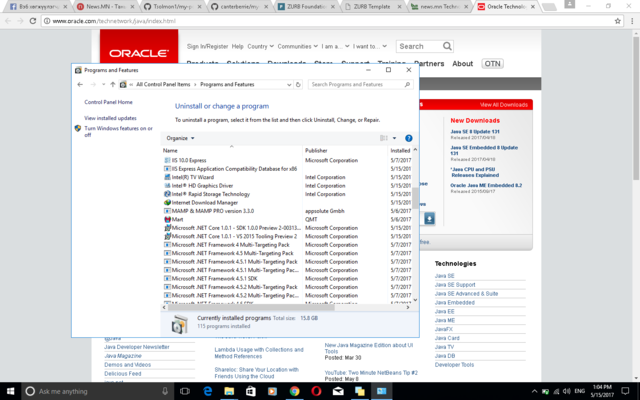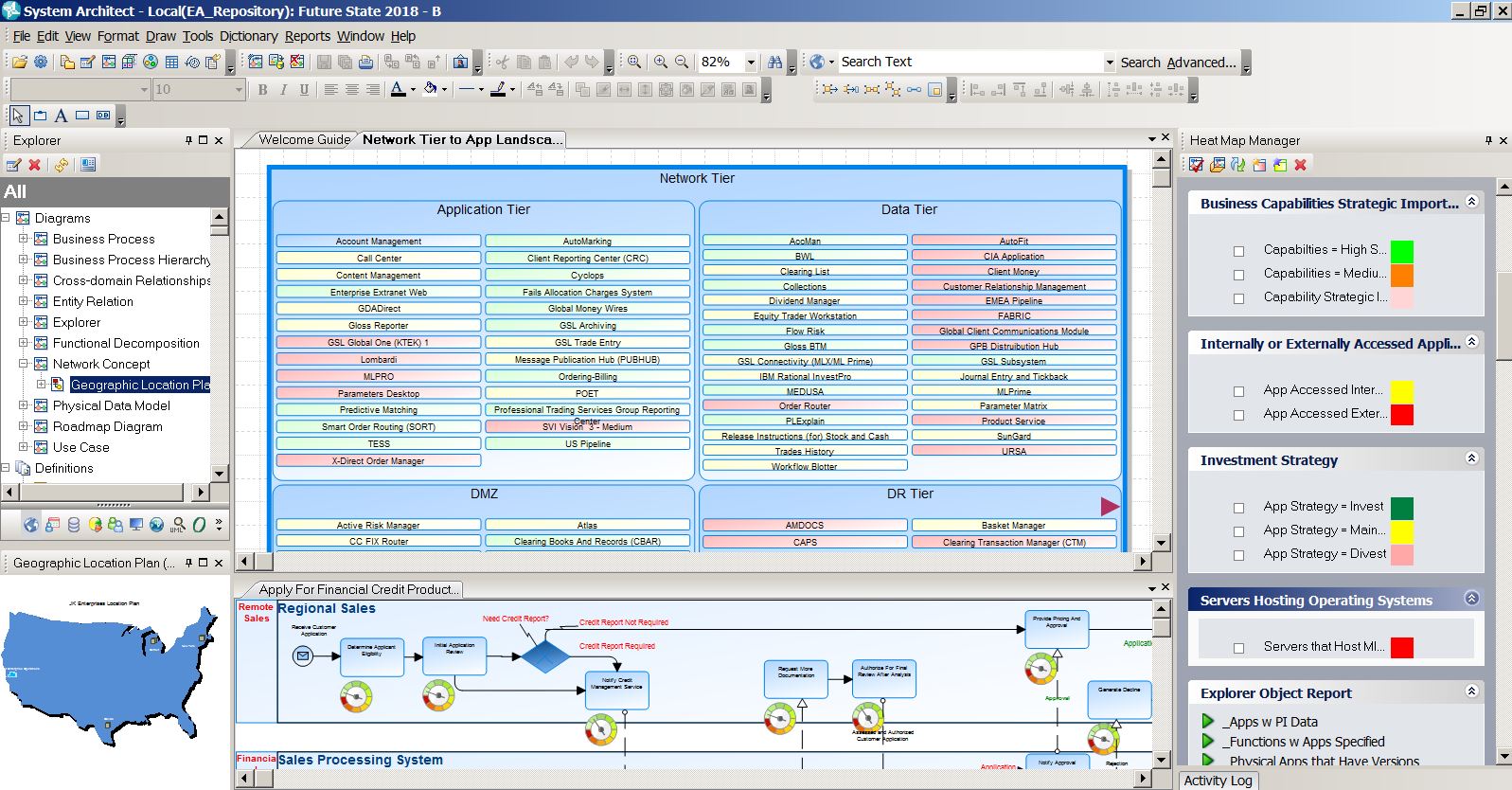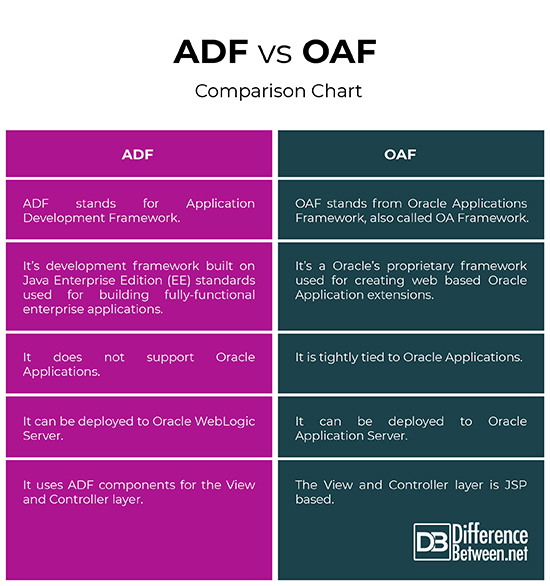Difference Between ADF and OAF
Oracle Application Development Framework (ADF) Vs. Oracle Application Framework (OAF)
It’s almost impossible to understand how the use of technology in business has evolved so much over the years. As hardware capabilities keep growing, software vendors are working more towards their offerings to include more and more features to support more business operations. In the early days, basic hardware was only capable of short processing routines and so it was up to organizations or enterprises to develop their own way to simplify processes. As a result, software industry started purchasing prewritten applications, mostly for functions and payroll. This is where Oracle Applications come to the picture, which was quick to expand its scope. The idea was to combine the features of different applications and offer it as a preintegrated set of supporting applications.
However, no technology is perfect and every new technology becomes obsolete over time. With the advent of technological evolution, enterprise applications are now more accessible than ever. As with the evolution, the profile of the ones who use enterprise applications has changed too. This brings in a new era of internet for business which laid the foundation for the tomorrow’s workforce. And Oracle ADF and OA Framework (OAF) are at the center of the evolution. Both are Oracle technologies used mainly for developing core technologies for Fusion Applications. Technology evolves rapidly and so does business applications with it, so a more definitive approach is required to fulfill their growing needs. So the question is should you use the OAF or the OA Framework to develop business applications?
What is Oracle ADF?
Oracle Application Development Framework (ADF) is the most productive framework available today for building custom applications. It’s an end-to-end application development framework built on Java Enterprise Edition (EE) standards used for building fully-functional web applications to meet a wide variety of needs. This powerful was only reserved for organizations and projects who would pay for an Oracle WebLogic Server License until 2012. Oracle finally released a limited version of Oracle ADF available for everyone. The goal is to build data-handling applications intended to gather data, process them, and display them as graphs or tables. Even beginners could use the powerful declarative features of ADF to build basic applications without having to write any code. ADF uses Java technologies to implement business logic specific to your application.
What is OA Framework?
OA Framework (OAF), short for Oracle Application Framework, is Oracle’s proprietary framework developed for Oracle E-Business Suite (EBS) applications. The original Oracle Applications was based on the early Oracle Forms product which would provide a terminal-based text view into the application back then. Java Forms client became much richer with time and with release of E-Business Suite 11i, Oracle started delivering specific products in HTML-based pages. With every release, more and more product began adopting the HTML-based user interface and by E-Business Suite 12.1 Oracle has made some significant developments and enhancements including a standard browser-based user interface design pattern, known as Oracle Applications Framework (OAF). Now with Fusion Applications, Oracle has taken OAF development principles to a whole new level.
Difference between ADF and OAF
-
Basics of ADF and OAF
Oracle Application Development Framework (ADF) is an end-to-end application development framework built on Java Enterprise Edition (EE) standards used for building fully-functional enterprise applications to meet a wide variety of needs. ADF is a part of the JDeveloper Integrated Development Environment (IDE) which provides developers all the power and flexibility to build enterprise applications. OA Framework (OAF) is a proprietary framework developed by Oracle to extend its E-Business Suite applications. It’s the development platform for the HTML-based business applications as well as the custom extension to the E-Business Suite applications.
-
Architecture of ADF and OAF
OAF is based on the industry-standard MVC design pattern which refers to the Model View Controller architecture and comprised of three layers: Model, View, and Controller. The XML Page forms the View which contains the display logic; the Java based controller controls the complete flow which makes it the Controller; and the Model takes care of the Data Base related transactions. ADF is also based on the Model-View-Controller architecture but comprises of four layers: Model, View, Controller, and Business Layer. Additionally, it provides solutions in the areas such as ORM, Reusable controller layer, Data persistence layer, rich web user interface based on JSF, and more.
-
Deployment of ADF and OAF
ADF is independent of Oracle Applications and can be deployed to Oracle WebLogic Server. Developers can test the applications using the Integrated WebLogic Server that is built into the JDeveloper installation and then deploy the applications to application servers. They can also use JDeveloper to deploy directly to a standalone application server. OAF, on the other hand, unlike ADF, cannot be used standalone; in fact, it’s tied to Oracle Applications and can be deployed only to Oracle Application Server. The WebLogic comes by default in Fusion Applications and ADF is at the center of the Fusion technology stack.
ADF vs. OAF: Comparison Chart
Summary of ADF Vs. OAF
While both ADF and OAF are Oracle technologies used mainly for developing core technologies for Fusion Applications using JDeveloper, OAF is tightly integrated with Oracle apps, whereas ADF does not even support Oracle Apps. Both are based on the Model-View-Controller design pattern, except ADF comes with an additional Business Layer. ADF is at the center of the Fusion technology stack, whereas OAF is the development platform for the Oracle E-Business Suite Applications and their extensions. Unlike ADF, OAF cannot be used standalone and can be deployed to Oracle Application Server. If you want to create a few pages with close integration with the Oracle E-Business Suite, then you can use OAF. If you’re building Fusion apps with no integration with E-Business Suite, then you should go for ADF.
- Difference Between Caucus and Primary - June 18, 2024
- Difference Between PPO and POS - May 30, 2024
- Difference Between RFID and NFC - May 28, 2024
Search DifferenceBetween.net :
Leave a Response
References :
[0]https://en.wikipedia.org/wiki/System_Architect#/media/File:Screen_shot_of_IBM_System_Architect_software.jpg
[1]Image credit: https://upload.wikimedia.org/wikipedia/commons/thumb/d/d4/Screeshot.png/640px-Screeshot.png
[2]Bingham, Richard. Managing Oracle Fusion Applications (1st ed.). NYC: McGraw-Hill Education, 2011. Print
[3]Vesterli, Sten E. Developing Web Applications with Oracle ADF Essentials. Birmingham: Packt Publishing, 2013. Print
[4]Mani, Sudhakar and Aarthi Sudhakar. OA Framework Beginners Guide. Morrisville, North Carolina: Lulu Press, 2013. Print



